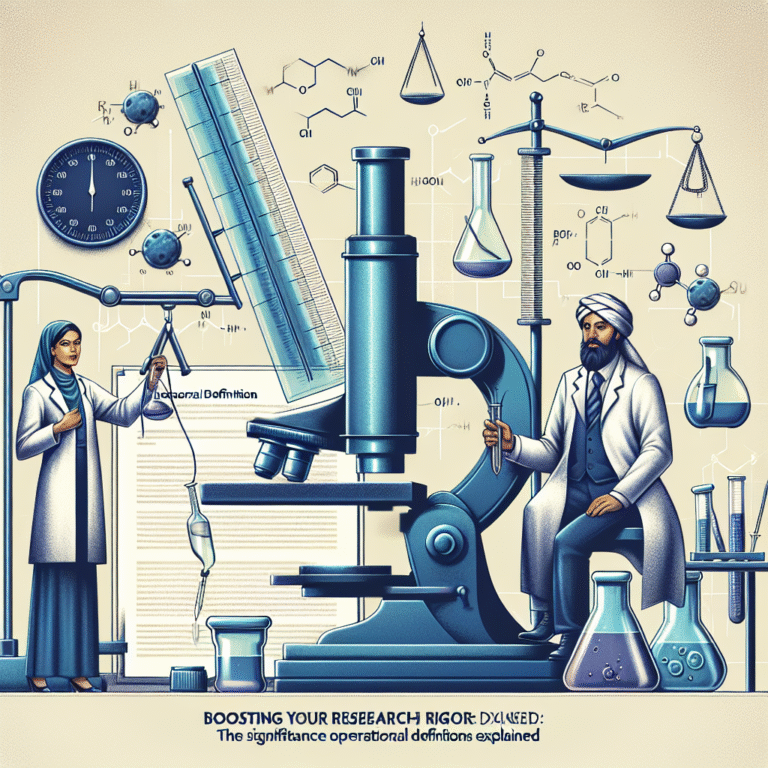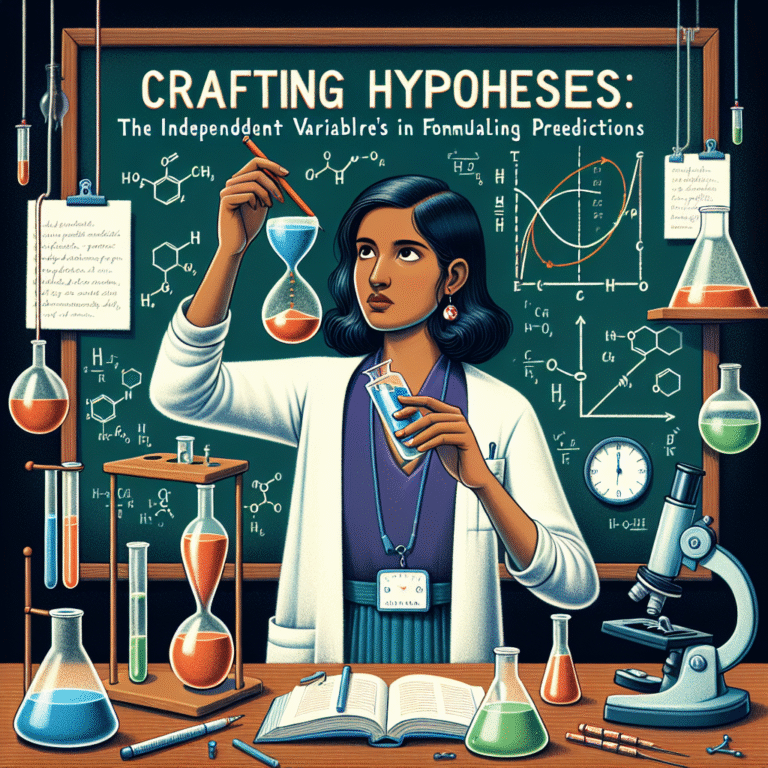
Introduction
Do you ever wonder what truly drives research outcomes? What single factor might influence your results more than any other? In the world of research design, the independent variable stands out as a cornerstone—a powerful determinant in shaping the course of an investigation. Whether you’re a seasoned researcher or embarking on your first study, understanding the role of the independent variable is paramount to your success. Welcome to The Essential Role of the Independent Variable in Research Design: A Comprehensive Guide, where we will delve deep into this critical concept.
Research is not merely about collecting data; it’s about sculpting that data into insights, patterns, and conclusions. To achieve that, researchers must manipulate or observe independent variables effectively. By the end of this article, you will not only grasp what an independent variable is but also learn how to wield it effectively in your research design.
Understanding the Independent Variable
What is an Independent Variable?
The independent variable is the variable that researchers change or control to test its effects on other variables, known as dependent variables. In essence, it’s the "cause" in a cause-and-effect relationship. If you think of a scientific experiment as a recipe, the independent variable serves as the ingredient you manipulate to observe whether it produces the desired outcome in the dish—the dependent variable.
Example:
Imagine a researcher studying the impact of different teaching methods (independent variable) on student performance (dependent variable). By altering the teaching methods, they can observe variations in students’ exam scores or attendance, clearly demonstrating the effects of these changes.
The Importance of the Independent Variable in Research Design
Understanding the role of the independent variable is essential for several reasons:
-
Establishing Relationships: It helps researchers establish causal relationships. Without manipulating the independent variable, determining whether changes in the dependent variable arise from that manipulation is impossible.
-
Guiding Hypotheses: Independent variables shape the hypotheses of a study. Formulating a hypothesis involves specifying what you believe will happen when the independent variable changes.
-
Strengthening Validity: Proper identification and manipulation of independent variables lend credibility to research, enhancing both internal and external validity.
- Facilitating Replication: Clearly defined independent variables help other researchers replicate the study, bolstering the research community’s collective understanding.
Types of Independent Variables
1. Manipulated Independent Variables
These are actively changed by the researcher during an experiment. For example, if a scientist doubles the amount of sunlight a plant receives to see its growth, sunlight exposure becomes the manipulated independent variable.
2. Subject Variables
These are characteristics of participants that cannot be manipulated but can still affect the outcome, such as age, gender, or education level. While researchers don’t directly manipulate these, they may select groups with distinct characteristics to study their influence.
3. Controlled Independent Variables
These are not the subject of the study but are kept constant to isolate the effects of the independent variable. In the plant example, water quality and type of soil might be controlled variables to ensure that sunlight is the only factor being manipulated.
Case Study: The Impact of Sleep on Academic Performance
To illustrate the practical application of the independent variable, let’s examine a case study on the effects of sleep duration on college students’ academic performance.
Study Design
Researchers designed an experiment where they manipulated the sleep duration (independent variable) among groups of college students. One group received the standard eight hours of sleep, while another group was restricted to four hours.
Results
Students who enjoyed a full night of sleep achieved significantly higher grades compared to those who were sleep-deprived. This study exemplifies how an independent variable can produce discernible changes in dependent variables—in this case, academic performance measured through test scores.
Analysis
By clearly defining and manipulating the independent variable (sleep duration), researchers effectively demonstrated a cause-and-effect relationship. The findings are significant not only for academic circles but also for mental health professionals, educators, and policymakers.
The Role of the Independent Variable in Hypothesis Formation
Crafting Effective Hypotheses
The independent variable is integral to hypothesis formulation. A well-structured hypothesis typically follows the format: “If [independent variable] is [manipulated], then [dependent variable] will [expected outcome].”
Example
“If college students sleep for eight hours a night (independent variable), then their academic performance (dependent variable) will improve compared to those who sleep less than six hours.”
Validating Hypotheses through Research Design
A robust research design is built on careful consideration of the independent variable. Here’s how to ensure the integrity of your hypothesis:
-
Operational Definitions: Clearly define how you will measure your independent variable. For sleep duration, a simple measure could be the number of hours slept each night.
-
Control Groups: To validate your findings, employ control groups. A group that maintains regular sleep patterns will provide a comparison benchmark.
- Randomization: Randomly assign participants to experimental and control groups to minimize biases and confounding variables.
Data Collection and Analysis
Measuring the Impact of the Independent Variable
Once you establish your independent variable, data collection becomes the next vital step. In the sleep study, for example, researchers may gather quantitative data—test scores, attendance rates, or qualitative feedback through surveys.
Tools for Data Collection
- Surveys: Effective for subjective measures, like students’ self-reported sleep quality.
- Tests: Standardized assessments yield quantifiable results for academic performance.
- Observational Studies: Researchers may directly observe study habits in different environments.
Analyzing Data to Extract Insights
The data collected will be analyzed to interpret the relationship between the independent and dependent variables. Here are common methods:
-
Statistical Tests: Utilize t-tests or ANOVA to determine whether observed differences are statistically significant.
-
Regression Analysis: This can help visualize the impact of the independent variable on the dependent variable.
- Graphs and Charts: Visualization tools can illustrate the relationships, making it easier to convey findings to stakeholders or fellow researchers.
Sample Table: Results from the Sleep Study
| Sleep Duration (Hours) | Average Test Score | Significance Level (p-value) |
|---|---|---|
| 4 | 65 | 0.01 |
| 8 | 85 | 0.01 |
Importance of Statistical Power
A crucial component of analyzing independent variables is understanding statistical power—the probability that the study will correctly reject the null hypothesis when it is false. High statistical power strengthens your conclusions and parenting potential biases in your interpretations.
The Challenges of Manipulating Independent Variables
Ethical Considerations
Manipulating independent variables comes with ethical responsibilities. For instance, researchers cannot ethically limit participants’ sleep to detrimental levels, even for the sake of research.
Ethical Guidelines
- Institutional Review Boards (IRBs): Most research institutions require approval from an IRB to ensure ethical guidelines are met.
- Informed Consent: Participants must be fully informed of any potential risks associated with the study.
Practical Limitations
-
Feasibility: Some independent variables may be difficult or impractical to manipulate, particularly in social science research.
- Participant Variability: Individual differences among participants can introduce variability that makes it difficult to isolate the effects of the independent variable.
Strategies to Overcome Challenges
- Use prior research to inform your design and understand potential limitations.
- Embrace mixed-method designs, including qualitative insights, to provide context and depth to your findings.
Conclusion
In conclusion, the independent variable is not just a term; it’s an essential pillar that supports the framework of effective research design. Understanding its role allows researchers to draw meaningful conclusions and foster a greater understanding of cause-and-effect dynamics. As you’ve explored in The Essential Role of the Independent Variable in Research Design: A Comprehensive Guide, mastering this concept can transform your research capabilities, enabling you to craft compelling hypotheses, analyze data effectively, and contribute to your field.
Motivational Takeaway
So, as you embark on your research journey, remember that the independent variable is not a mere concept but a powerful tool at your disposal. Harness its potential, embrace the challenges, and let your curiosity lead you to meaningful discoveries.
FAQs
1. What is the difference between an independent variable and a dependent variable?
The independent variable is manipulated by the researcher to observe its effects, while the dependent variable is the outcome being measured.
2. Can an independent variable have multiple levels?
Yes, independent variables can have multiple levels, such as different doses of a medication tested against control groups.
3. How do I determine the best independent variable for my research?
Choose an independent variable that directly relates to your research question and has a theoretical or empirical basis for expected effects.
4. What role do confounding variables play in research?
Confounding variables can obscure the true relationship between the independent and dependent variables, leading to misleading conclusions.
5. How can I ensure ethical research practices when manipulating independent variables?
Engage with your institution’s IRB, obtain informed consent from participants, and be transparent about the study’s potential risks.
By grasping the essence of the independent variable, you are better equipped to navigate the research landscape and turn your investigative queries into impactful studies. Happy researching!


















